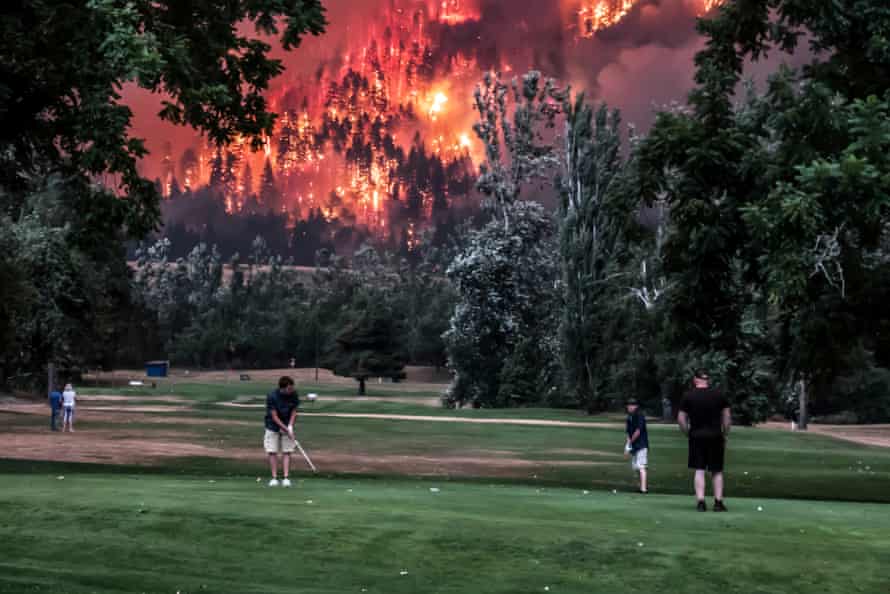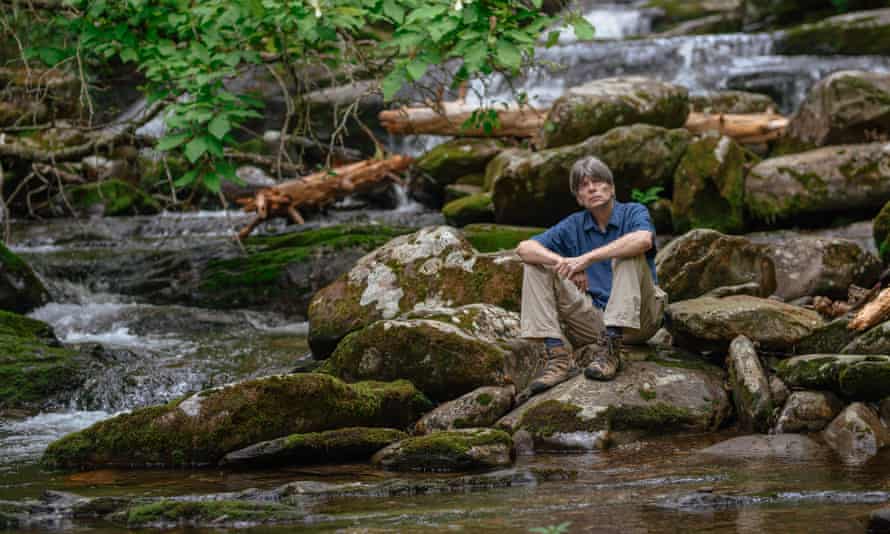In September 2017, David Simon, creator of The Wire, tweeted a photograph of golfers calmly lining up their putts on a Florida course as wildfires raged in the background. “In the pantheon of visual metaphors for America today, this is the money shot,” he wrote of the picture, which was taken by an amateur photographer who spotted the photo-op as she was about to skydive out of a plane. Everything about this story – the image, the circumstances – seems stranger than fiction.
A year before Simon’s tweet, in a landmark polemic, The Great Derangement: Climate Change and the Unthinkable, Indian novelist Amitav Ghosh had questioned why so few writers – himself included – were tackling the world’s most pressing issue in their fiction. But now, as extreme weather swirls around the globe, melting glaciers, burning forests, flooding districts and annihilating species, the climate emergency has brought the unimaginable into our daily lives and literature. A survivor in Jessie Greengrass’s haunting new novel The High House sums it up: “The whole complicated system of modernity which had held us up, away from the earth, was crumbling … and we were becoming again what we had used to be: cold, and frightened of the weather, and frightened of the dark. Somehow while we had all been busy, while we had been doing those small things which added up to living, the future had slipped into the present.”

Greengrass is among a growing number of novelists who are confronting this unfolding catastrophe through the young genre of climate fiction – or “cli-fi”. Among the new arrivals are the Irish writer Niall Bourke, whose novel Line conjures the Boschian image of refugees queueing for generations in an arid land; and Bethany Clift, whose Last One at the Party is the diary of an unnamed thirtysomething who decides to revel her way to the end, as the sole survivor of a pandemic. In August, Alexandra Kleeman’s Something New Under the Sun will take us to a climate-ravaged near-future California. And in September, Anthony Doerr will follow his Pulitzer-winning novel All the Light We Cannot See with Cloud Cuckoo Land, set between 15th-century Constantinople, Idaho in 2020 and space some time in the future. Doerr has said of the book: “The world we’re handing our kids brims with challenges: climate instability, pandemics, disinformation. I wanted this novel to reflect those anxieties, but also offer meaningful hope.”
So what has changed since Ghosh published The Great Derangement? “I think that the world has changed us, and the inflection point was 2018,” he says now. “It was partly because there were so many extreme climate events that year – the California wildfires, flooding in India, a succession of brutal hurricanes – but partly also because of the publication of Richard Powers’s The Overstory.”
This is a big claim to make for a novel. His point, says Ghosh, is not just about the book itself, but the welcome it received (including being shortlisted for the Booker prize). “It wasn’t hived off into the usual silos of climate change or speculative fiction, but was treated as a mainstream novel. I do think that was a very major thing. Since then, there’s been an outpouring of work in this area. In my own personal inbox, I get two or three manuscripts a day.”
Powers’s Pulitzer prize-winning novel reduces human lives to slim growth rings in the bigger history of trees, with characters whose separate stories fleetingly intersect as they circle around a series of confrontations between individuals and institutions, conscience and greed, that will determine the future of humanity. The Canadian writer Michael Christie repeated this structure two years later in a lively eco-parable Greenwood, set between 1908 and 2038, when a virulent new fungus is killing off all trees in what is known as “the great withering”.
At the heart of both novels is a debate about what constitutes life itself. In The Overstory, a research scientist is cast into the wilderness for daring to suggest that trees have their own forms of consciousness and community, while an entrepreneurial computer geek realises that they hold the secret to everything. In Greenwood, Jake, a tourist guide at a futuristic nature theme park, reflects: “Even when a tree is at its most vital, only ten per cent of its tissue – the outermost rings, its sapwood – can be called alive. Every tree is held up by its own history, the very bones of its ancestors.”

This isn’t so fanciful, given the “rights of nature” movement, which Robert Macfarlane has described as “the new animism”. Two years ago, Macfarlane reported on a move by residents of the US city of Toledo to draw up an emergency “bill of rights” for Lake Eyrie, granting it legal personhood and according it rights in law to “exist, flourish, and naturally evolve”. But it wasn’t quite that simple. “Ecosystems are not human, and they certainly don’t bear human responsibilities,” argued the bill’s organisers. “Rather, nature requires its own unique rights that recognise its needs and characteristics.”
The bill revealed just how difficult it is for our existing legal and intellectual frameworks to accommodate the idea of a reality beyond the human. “The [climate] crisis demands a form of literary expression that lifts it out of the realm of intellectual knowing and lodges it deep in readers’ bodies,” wrote a perceptive reviewer, in response to an Amazon collection of standalone cli-fi stories, Warmer, published in 2018.
So what are the stories we need and how do we unlock them? “There are many different kinds of stories one might tell but there are no general answers when it comes to novel writing, only specific ones,” says Margaret Atwood, whose MaddAddam trilogy explores what might happen in the aftermath of environmental collapse. Cli-fi often rests on the familiar trope of a nightmarish new reality unleashed by a catastrophic event. In John Lanchester’s recent novel The Wall, “the change” has eroded beaches and made Britain into a fortress state, patrolled by young defenders under instruction to destroy any boat that approaches. Kate Sawyer’s debut novel, The Stranding, published on 24 June, opens with the striking image of two strangers who save themselves from a life-obliterating radiation event by sheltering in the mouth of a beached whale.
Both The High House and Rumaan Alam’s 2020 hit, Leave the World Behind, do something a bit different. Alam strands his characters in a Long Island holiday home, cut off from “civilisation” by a cataclysm that presents itself as a mysterious noise, a noise so extreme that it seems to transcend sound. “You didn’t hear such a noise: you experienced it, endured it, survived it, witnessed it. You could fairly say their lives could be divided into two: the period before they’d heard that noise and the period after,” he writes. In The High House, self-sufficiency is made possible by a barn thoughtfully stocked by the scientist mother of one of the characters with the tools of a past civilisation – trainers, and tinned foods.

Greengrass describes her novel as “a sort of prequel” to Russell Hoban’s great dystopian fantasy Riddley Walker, where – in the absence of writing materials – language has degraded and mutated. Her East Anglia, like Alam’s Long Island, is on the way to becoming a dystopia, without actually yet being one. The characters of both novels are trapped between the “before” and the “after”, in precisely the sort of limbo that makes the environmental breakdown so hard to write about.
Apocalyptic fiction has long thrummed with biblical imagery, from the hymn-singing “God’s gardeners” of Margaret Atwood’s The Year of the Flood to the “burning bush” of orange butterflies in Barbara Kingsolver’s Flight Behaviour. Both The High House and The Stranding invoke the story of Noah’s Ark, creating sealed-off family communities while implicitly asking what such survival could mean in a world without olive trees, or doves.
In the novel Gun Island – his 2019 answer to his own provocation – Ghosh deploys myth and mysticism, and the historic movement of languages, animals and people around the globe. The novel climaxes in a mass migration of whales and dolphins, an implausible freak event that is also an observable physical phenomenon. At its heart is a reclamation of the “uncanny”, defined by Freud as an effect produced by effacing the distinction between imagination and reality.
Alam also uses the uncanny to slice through the hyper-real surface of Leave the World Behind, most strikingly with a flock of flamingos that land in the backyard swimming pool. “They’re comic and unsettling,” says the novelist. “They’re a colour that doesn’t feel like it should exist in nature, but of course it does. And they certainly shouldn’t be in the American northeast. It’s like coming across a zebra in the middle of London. It feels to me a little mythic, a little like the arrival of Zeus as a swan.”
It is also a strangely scary visitation. “I think that we have had all of these moments in the news that are frightening and strange, and we have to think of them as uncanny because they seem to contain something that we can’t comprehend right now,” says Alam. He cites shocking images of drowned children from refugee boats washed up on beaches. “Those were real people, and there is so much heartbreak and shame for us to bear in these moments. But there is also something very hard to figure out about them: an unexplained child washed up on the shore almost feels like something out of folktale.”
Like Gun Island, Leave the World Behind is a deliberately hybrid novel – part social comedy, part speculative chiller. Hybridity is emerging as one way of addressing the central contradiction between what we are (social beings with lives constructed from familiar rituals) and what confronts us (an elimination so total that, as Greengrass writes, “there won’t be memorials in church halls. No one is going to make up songs. There will be nothing left”).
In The Last Migration, the Australian writer Charlotte McConaghy slips between the magical, the speculative and the domestic in a compelling ocean-going yarn that tracks the world’s last migrating birds across the high seas, in the hope that they may reveal the whereabouts of the last fish. Its narrator, Franny, has a sentimental attachment to one of the three tagged arctic terns she is tracking. “I’ve taken to thinking of her as mine because she has burrowed inside and made a home in my ribcage,” she says, when the reality is that the bird is just a dot on a sonar panel, and finally an absence.
Jeff VanderMeer also embraces hybridity in Hummingbird Salamander, abandoning his usual speculative fiction to spin a pacy thriller plot around a missing eco-terrorist. “Using ‘us’ when thinking about the environment erases all the different versions of ‘us’,” writes the fugitive Silvina. “Many indigenous peoples don’t think this way. Counterculture doesn’t always think this way. Philosophy, knowledge, policy exist that could solve our problems already.”
Other writers have squared up to the narrative challenge by refusing to join the dots entirely, as Jenny Offill does so brilliantly in her scorching short novel Weather, composed of sometimes random paragraphs. Its narrator, Lizzie, is a librarian whose conscience is besieged by catastrophe aphorisms (“first they came for the coral, but I did not say anything because I was not a coral …”), while her “monkey brain” worries about what will happen to her teeth in a world without dentists, and her socialised one frets that she might have got lipstick on them.
It is not just overtly cli-fi novels that are investigating fragmentation as a way of expressing our state of dismay and disarray. In Sarah Moss’s Summerwater, holiday-makers struggle to enjoy themselves in unseasonably heavy rain, oblivious to a natural world that exists only in the parenthesis of standalone preludes to each chapter: bees dying, ants walling themselves in. In Lucy Ellmann’s Ducks, Newburyport, a lioness tries to keep her cubs safe, a narrative thread related outside the stream-of-consciousness of the central character, who spews out the minutiae of her life over 1,030 pages.
In their different ways, both Moss and Ellmann are addressing the solipsism or self-centredness of consciousness, which got us into this problem in the first place, and is both formed and enacted through the stories we tell about ourselves. Their characters are prisoners of what the Polish novelist Olga Tokarczuk, in a visionary Nobel lecture, described as “the polyphonic first-person narrative”, which filters everything through the self of the storyteller.
Tokarczuk, who laid out her environmental agenda in her eco-whodunnit Drive Your Plow Over the Bones of the Dead, called for a return to the perspective of parable, and for the development of what she called a “tender narrator”, a quantum version of the omniscient narrator, capable of seeing in many dimensions. Quite how this would work she didn’t know, because it had yet to be invented. In the meantime, we should abandon traditional distinctions between high- and lowbrow fiction and trust to fragments. “In this way,” she said, literature can “set off the reader’s capacity to unite fragments into a single design, and to discover entire constellations in the small particles of events.”
But as long as we continue to think and to tell stories, we are not necessarily doomed. For decades Atwood’s novels have been sounding the alarm about things that may not yet be visible, though they are already coming to pass. “There is no inevitable The Future, just as there is no inevitable Right Side of History. There is no inevitable Road to Perdition, there is no inevitable Road to Oz,” she says. “But there are consequences of actions, not all of them foreseeable. Dark are the ways of wizards. And of novelists as well.”
Average Rating